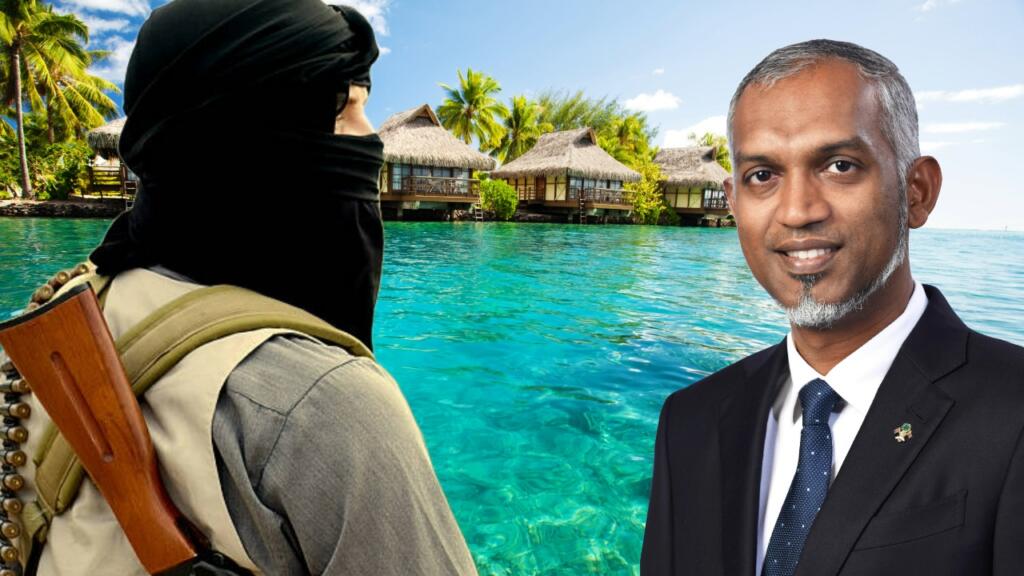The situation in Maldives is worrying for India. Political groups and Islamic Organizations in Maldives are increasingly speaking against India. This is a big concern for security in Delhi, India’s capital. They think this change is because people who went to religious schools in Pakistan, Saudi Arabia, and Afghanistan are now part of the government in Male, the capital of Maldives.
For a long time, experts from Maldives who live in other countries talked about this issue. They noticed that extreme religious beliefs were growing fast in Maldives. This is now becoming more visible in the country’s politics.
How the Demographics of Maldives Changed
In 2022, the Maldives had a population of 5.15 lakh (515,000). Out of this, 1.32 lakh (132,000) were foreigners, mainly from South Asian countries, working in various jobs. The country is made up of 189 islands, 18 atolls, and 4 cities.
Maldivians were mostly Buddhist for many years but changed to Islam in the 12th century. In the last 20 years, people from Pakistan and Saudi Arabia have come to Male, the capital, in large numbers. Most of these people were part of groups with strong religious views.
Many of these groups were connected to communal and armed organizations. One such group is Idara Khidmat-e-Khalq, linked to Lashkar-e-Taiba. This group, labeled a terror group by the US in 2006, used its presence in Male to spread their version of Islam.
These groups took young people from Maldives to Pakistan and Saudi Arabia for religious training. Many Maldivian youth went to religious schools in Pakistan and even visited training camps near the Afghanistan-Pakistan border.
2004 Tsunami and beyond
The 2004 tsunami was a turning point. It caused a lot of damage in Maldives. After the tsunami, groups pretending to be charities, but actually linked to regional terrorist organizations, came to Maldives. They provided help and money to those affected. These groups also influenced the local population with their ideas. They sent some youths to religious schools in Pakistan, while others were recruited for more dangerous activities. Laamu atoll, in the southern part of Maldives, was one of the worst-hit areas.
The IKK, part of Jamaat-ud-Dawa and Lashkar-e-Taiba, played a big role in these activities. These groups have carried out attacks in India, Pakistan, and other places. Their influence in Male has led to a change in the religious views and practices in the country. This shows how much radicalization has happened in Maldives.
In December 2019, the Islamic ministry of Maldives took action against three scholars. These scholars were accused of promoting terrorism, spreading hate, and supporting violent acts in other countries. This happened because intelligence found that around 1,400 extremists in Maldives might commit violence in the name of Islam.
The Commissioner of Police, Mohamed Hameed, gave some important numbers at a conference. He said that about 423 Maldivians tried to join terrorist groups in Syria and Iraq. Out of these, 173 actually got into the war zones. Before the war in Syria, hundreds went to Pakistan and Afghanistan. Some of them came back to Maldives and started spreading radical ideas.
Maldives had the highest number of foreign fighters per person going to Syria and Iraq to join ISIS. Just a few days before, on November 5, 2019, the Maldivian government shut down the Maldivian Democracy Network (MDN). This NGO worked for human rights and democracy in Male. The government and the Islamic Ministry said a four-year-old report by MDN was against Islam.
The MDN report warned that foreign-funded extreme religious ideas were changing traditional beliefs in Maldives. This was harmful to the country’s progress and democratic values. During President Abdulla Yameen’s time in office, from 2013 to 2018, Maldives had the most fighters per person going to Syria.
Transparency International found that local politicians in Male ignored extremist recruitment because they needed support from criminal gangs and extremist sympathizers. Many extremists who returned were sent to a de-radicalization center on Himmafushi island, now called the “national integration center”. It’s managed by the Ministry of Home Affairs. In October 2020, a Maldivian man, arrested after returning from Syria for terrorist activities, was the first detainee at this center.
In July last year, the US Department of the Treasury’s Office of Foreign Assets Control (OFAC) identified important ISIS and al-Qa’ida figures in Maldives. This included 20 operatives from ISIS, ISIS-Khorasan (ISIS-K), and al-Qa’ida. OFAC also targeted 29 companies linked to these individuals. These include leaders of Maldives-based gangs and associates of Mohamad Ameen, an ISIS-K recruiter designated by OFAC in 2019.
India – the friend Maldives needs
India and Japan have helped Maldives fight terrorism. In September 2019, India and Maldives agreed to assist each other in criminal matters, especially terrorism-related crimes. In October of the same year, Japan gave Maldives 500 million yen to strengthen their counterterrorism efforts, focusing on ISIS and other Islamic terror groups. However, China and Pakistan, two Maldivian allies, haven’t made similar efforts.
Despite India’s policy of being the first responder to Male in emergencies, this hasn’t stopped Islamic fundamentalists from advancing their agenda.
In June 2022, Sheikh Adam Nishan and Sheikh Fazloon Mohamed, local Islamist scholars, and Mohamed Ismail from the Progressive Party of Maldives, were arrested. They were accused of leading a mob that attacked people at a “Yoga Day” event in Maldives’ national football stadium. This event was organized by the Indian High Commission.
Recently, some Maldivian Cabinet members in insulted Indian institutions. This shows the direction the current leadership in Male might take in the future. As of mid-December, Maldives welcomed 1,757,939 tourists. The most visitors were from India (209,198), followed by Russia (209,146), and China (187,118). However, due to concerns about growing Islamist fundamentalism, these tourist numbers might decrease in the coming months.
